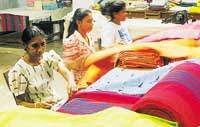|
Preserving a
dying industry
Dressed in a printed cotton top and skirt, seated behind a huge table, she was glowing with happiness as she spoke of her struggle to preserve a dying industry. Sita Yahampath, proprietor of Kandygs Handlooms (Exports) Ltd is a simple lady. Her table is full of photographs taken at a recent exhibition, an award won at a recent exporters' awards ceremony, a number of files and a jar full of colourful felt-pens. Celebrating 30 years of production in the handloom sector, Ms. Yahampath is content with her achievements over the past 30 years. Kandygs Handlooms (Exports) Ltd, situated in a compound full of thick foliage, came into existence in 1972 when Yahampath's husband, Felix, met Bhangavandhas Hirdaramani who was in search of a reliable person to run his handloom factory in Sri Lanka. His factory had been closed and Hirdaramani had wanted the Yahampaths to start afresh and produce the handloom he wanted for his factory in India. Accepted
challenge What seemed
like a monotonous idea at the beginning, now occupies most of Ms.
Yahampath's time as she experiments with colours and designs for
her fabrics. Today, her daughter trained in textile designing assists
her in designing the fabric. They also have four different factories doing contract weaving for them and another 100 doing sewing on a contract basis. Their main product is the fabric they produce. But in addition they do upholstery, bedspreads, table linen, cushion covers and even soft toys. However, starting with 10 machines and 16 employees from Hidaramani's venture, the learning process has been difficult for Ms. Yahampath, who had to learn through experience. "I didn't know anything about handlooms but learnt through my employees." Running the factory on her own at the beginning had been no easy task. Ms. Yahampath, bored by the red fabric she produced day-in and day-out, started experimenting with colour and designs. "I was interested in doing different things. I was bored doing the same thing and wanted to try something different." Introducing new designs and colours, she has sought her husband's help to market the products. But he had not been in a position to help her. "He was in the police and hardly had any time to help me." Hirdaramani, however, had offered his support from the beginning and asked Ms. Yahampath to use the material left from his former venture. "He encouraged me and told me that I would become one of the best weavers in the country." Exclusive
clientele While she prefers to create earthy shades like bottle green, chocolate brown and mustard, the factory dabbles with a variety of colours like royal blue, scarlet, yellow, orange, magenta and mauve. Royal blue is the most sought after of the colours and red and green have an increase in demand during Christmas. Handloom is an expensive product yet Kandygs has a steady clientele. "We produce for the upper segment because quality handlooms cost a lot. If you do it well, it will be expensive. You cannot produce quality things cheap, the weaves become intricate and dying becomes expensive." After Hirdaramani's death, the Yahampath's set off on their own. "It was very difficult to sell the products on our own in Pettah and we had to explore other possibilities." Realising the market potential of their product, they started their own shop in 1976. But the Yahampaths' journey towards success was not an easy one. The production has been more or less the same. But right now, Kandygs does more intricate and complex designs than those done in the past. "They are difficult to weave and take a long time. But we use traditional weaves like the malbana design to ensure the strength and durability of the product." Handloom is a special industry according to Ms. Yahampath because the designs can be varied from 100 metres to 100 metres. "Power-loom and imported material can be changed from 500 - 1000 metres." Besides, it is only an exclusive clientele that prefers handloom products. "They prefer hand-woven and Sri Lankan things and we feel that they get value for money." Having been in the trade for 30 years, Ms. Yahampath hopes to launch a soft toy range very soon. "I would prefer to call them activity toys than soft toys. There are a few cuddly toys but most of them are activity toys. I hope to introduce them at a trade fair," said Ms. Yahampath who has high hopes for the development of the handloom sector of this country. State assistance People don't come running to do hand weaving because it is very hard. A person who comes to weave is a person who cannot find employment anywhere else. That is the sort of person we have to look after." Hand weaving extracts a lot of energy and proprietors ought to look after their weavers in order to preserve this dying art, says Ms. Yahampath who feels that this becomes difficult when the proprietor faces financial constraints. "Handloom is a workforce-based industry and you must continue to use your employees whether you have the money or not. You cannot keep them idling even if the products are not moving." It becomes increasingly difficult for handloom manufacturers to produce material when the government draws money from the handloom sector, says Ms. Yahampath who feels that the industry ought to be encouraged by providing incentives to manufacturers. "Handloom has enormous potential. We can do beautiful things if we plan right and even export the material. But taxes imposed on the industry affect both the customer and producer. My fervent hope is that the 20 percent tax will be reduced in the forthcoming budget because it is a lot to ask from the consumer." (NG) |
||||
Copyright © 2001 Wijeya Newspapers
Ltd. All rights reserved. |
